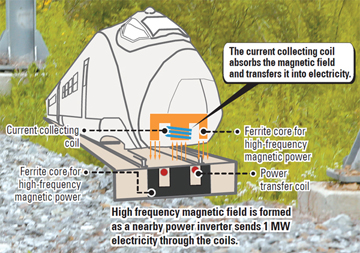Test run a success for wireless train

A wireless train that runs on magnetic technology travels along a 150-meter (492-feet) stretch of railroad in Uiwang, Gyeonggi, yesterday. The train was developed by the Korea Railroad Research Institute. The institute plans to commercialize the technology in five years. Provided by the institute
Although the technology is used in other types of vehicles, yesterday was the first time the wireless technology has been used to power a bullet train.
The Korea Railroad Research Institute tested the train on Tuesday on a 150-meter (492-feet) stretch of railway it built in Uiwang, Gyeonggi. The test moved the train at three to four kilometers per hour.
“The institute aims to start commercializing the wireless power technology on light rails in next five years,” said Lee Jun-ho, a senior researcher at the institute. “We will keep researching to advance the technology to make it applicable to subways and bullet trains like KTX.”
So far, only electric vehicles and light-rail trams are successfully using the technology, and unlike the new bullet train, they require batteries that must be charged. These vehicles also have less electricity capacity.

But for the train, the Korean power-transfer technology carries and transfers a high volume of electricity, up to one megawatt, which is about 10 times that of electric buses and light rail trains. The train generates its own electricity as it runs.
A power inverter located near the railway sends electricity of about one megawatt through power-transfer coils installed in the middle of track. The electricity forms a high frequency magnetic field of about 60 kilohertz, by switching the polarization from plus to minus 60,000 times per second. As the magnetic field spreads, a line of current collector coils in the train above the power-transfer coil in the track absorbs the magnetic field and immediately transfers it into about 1.2 megawatts of electricity.
Each collector coil transfers 300 kilowatts and one train car has four coils. As the train travels along, the coils in the train and the line coils in the track generate energy simultaneously.
The power-transfer facility in the track can also carry 300 kilowatts, about 3.3 times more electricity than the coils used for light-rail trams.
However, more tests must be done before the new bullet trains can be commercialized.
To power bullet trains at faster than 400 kilometers per hour, the power-transfer facility must have a capacity of about nine megawatts. Lee, the lead researcher of the project for the railway institute, said that his team will continue developing the coils so that they can receive and transfer larger amounts of electricity.
High-speed trains like KTX were able received their huge amounts of power though electric cords hanging above the trains like a spiderweb. Without the cords, the businesses running the trains can save up to 52 percent of operating cost in maintenance.
BY KIM JI-YOON [jiyoon.kim@joongang.co.kr]










with the Korea JoongAng Daily
To write comments, please log in to one of the accounts.
Standards Board Policy (0/250자)